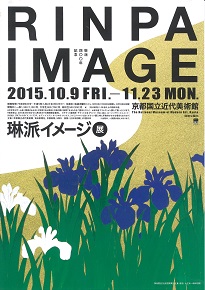Event
400th Anniversary of the Rinpa School: The “RINPA” Image
Oct 9, 2015(fri) – Nov 23, 2015(mon)
Admission:
Adult: 1,300yen(1,100),
University students: 900yen(700),
High school students : 500yen(300)
under 15 years of age:free
(Advance or Group of Admission)
http://www.momak.go.jp/English/exhibitionArchive/2015/410.html
Venue
The National Museum of Modern Art , Kyoto
http://www.momak.go.jp/English/
Access: Okazaki Enshoji-cho, Sakyo-ku, Kyoto 606-8344,
Japan
Tel: 075-761-4111
Hours: 9:30 ~ 17:00/Tuesday ~ Thursday・
Weekend, national holiday(entry up to 30 minutes before closing.)
9:30 ~ 20:00/Friday
(entry up to 30 minutes before closing.)
Closed: Monday
Description
The Rinpa school was represented by artists such as Tawaraya Sotatsu, Ogata Korin and Kenzan, Sakai Hoitsu and Suzuki Kiitsu during the Edo period. Yet “Rinpa” is somewhat of a misnomer in that the style was not passed on through an organization or through teacher-student relationships. It comprised independent artists, each of whom admired the work of his predecessors and reverently followed their styles, eventually developing the school as a whole. The fact that there is a 100-year disparity between Sotatsu and Korin attests to this unique form of development.
Even though many other schools of art have not been able to survive to this day, the Rinpa school has continued to thrive in a variety of fields. This is precisely because throughout its history the Rinpa school has always been favored as a fresh, liberated and attractive style.
This year marks the 400th anniversary of the establishment of an artistic village in Takagamine, Kyoto by Hon’ami Koetsu (1558-1637) in 1615. Koetsu, who is considered as having started the Rinpa school, received the land from Tokugawa Ieyasu, the founder of the Tokugawa Shogunate Government, specifically for this purpose. Celebrating such a memorable year, this exhibition introduces the extensive influence of the Rinpa school in modern-contemporary art, by featuring approximately. 80 works by artists influenced by the Rinpa school in fields such as paintings, crafts, woodblock prints, fashion and graphics, all of which have been classified into 3 categories.
The exhibition features masterpieces of modern-contemporary art, including both works easily recognized as being of the Rinpa school and works which merely offer hints of having been influenced by the Rinpa style. It will be an unparalleled opportunity to deepen one’s understanding of the Rinpa school which was born in Kyoto and has continued to spread its radiance throughout the world.





